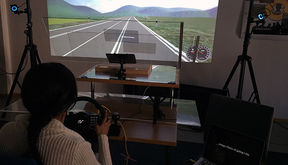Typing while driving could be more safe with simple text entry technique

The study was implemented with a driving simulator. The researchers intended to find a solution in which the driver would need to look at the keypad as little as possible and could keep eyes on the road. Photo: Gabriela Villalobos Zúñiga
Texting while driving is a situation that occurs globally. In Finland the use of a smartphone or any other communication device is prohibited in a manner that may hinder the use of the vehicle controls or otherwise distract the driver while driving.
Researchers at Aalto University and University of Jyväskylä showed that a new text entry technique may help drivers keep their eyes on the road better than when they are tapping a touch screen. The number of situations with the driver drifting out of the lane was 70 per cent lower. The study was implemented with a driving simulator. The test persons were driving in virtual urban and rural environments and texting sentences familiar from text messages.
‘Our study was motivated by the dangerous use of smartphones during driving. Despite dangerous situations and the legislation, texting while driving or using for example navigation buttons is a global manner. We were trying to come up with a solution in which the person’s driving would not be distracted,’ says Professor Antti Oulasvirta from Aalto University.
Technical implementation would be affordable
The researchers intended to find a solution in which the driver would need to look at the keypad as little as possible and could keep eyes on the road. The same mechanism is also use to input for example GPS destinations, phone book addresses or names.
‘In our tests, we used a transparent reflective film on the windscreen for the projection. It was important to position the text display so that it did not block the driver’s view of the road, but was still close enough to the road for the driver to be able to observe it while keeping an eye on the text being typed,’ says Oulasvirta.
The researchers’ idea is simple and affordable. The T9 keypad used in the tests was a 12-key panel connected to predictive text input, and it was attached to the steering wheel. The keypad costs a few dozen euros. Head-up display technology is also becoming more common in cars and there are affordable alternatives available.
‘The advantage of the T9 keypad, familiar to us from Nokia phones, is that it is normally not necessary to press a key for more than once to insert a letter. Everyone who has used these keypads knows that you do not need to focus your vision on the keypad in the same way as you do with touch screens.’
The results are positive, but they are based on one study made in a simulator. To implement the results as a product, the researchers will need to carry out more studies, especially with users who have never used a T9 keypad before. Driver’s eyes on the road does not either necessarily mean that the driver’s mind is on the road.
What about the dangerous situations caused by the use of smartphones? Will they disappear when self-driving cars make a breakthrough?
‘I don’t think so. It will be a few years before self-driving cars make a breakthrough, and they will not be operating everywhere, at least not for the first few years,’ says Oulasvirta.
The research will be presented at the international AutoUI conference in the United States between 24 and 26 October.
Further information:
Professor Antti Oulasvirta
Aalto University
tel. +358 50 3841 561
antti.oulasvirta@aalto.fi
Postdoctoral Researcher Tuomo Kujala
University of Jyväskylä
tel. +358 400 247 392
tuomo.j.kujala@jyu.fi
Gabriela Villalobos Zúñiga, MSc (Tech.)
Aalto University
gabriela.villalobos@alumni.aalto.fi
Read more news

Your voice gives away valuable personal information, so how do you keep that data safe?
With speech technologies becoming increasingly common, researchers want to make sure we don’t give away more information than we mean to.
Aalto in 2025: Quantum leaps, creative breakthroughs and solutions for a better life
Growth, technology and industrial renewal; human-centred solutions; health and everyday wellbeing; and enjoyable daily life and thriving communities.
Research Council of Finland establishes a Center of Excellence in Quantum Materials
The Centre, called QMAT, creates new materials to power the quantum technology of coming decades.






